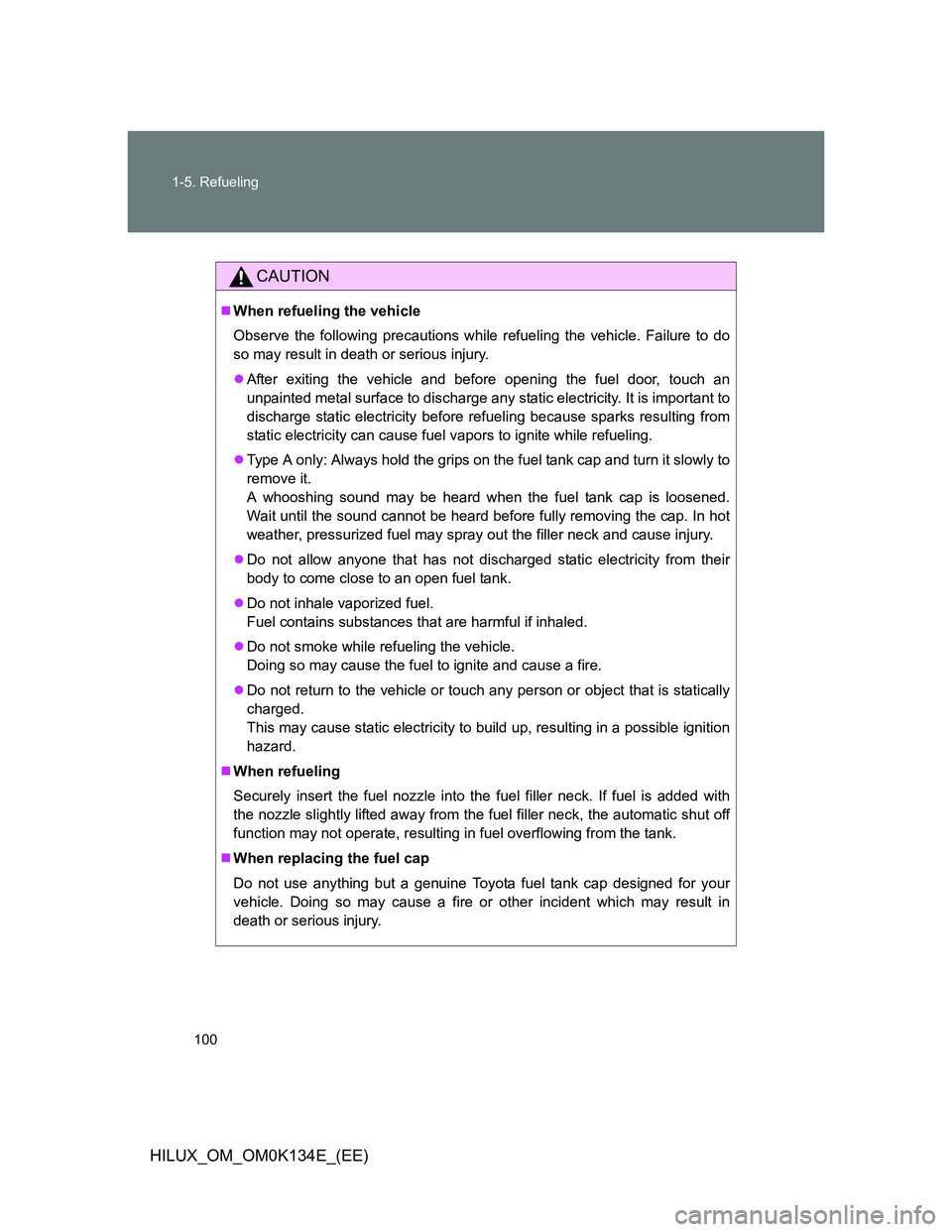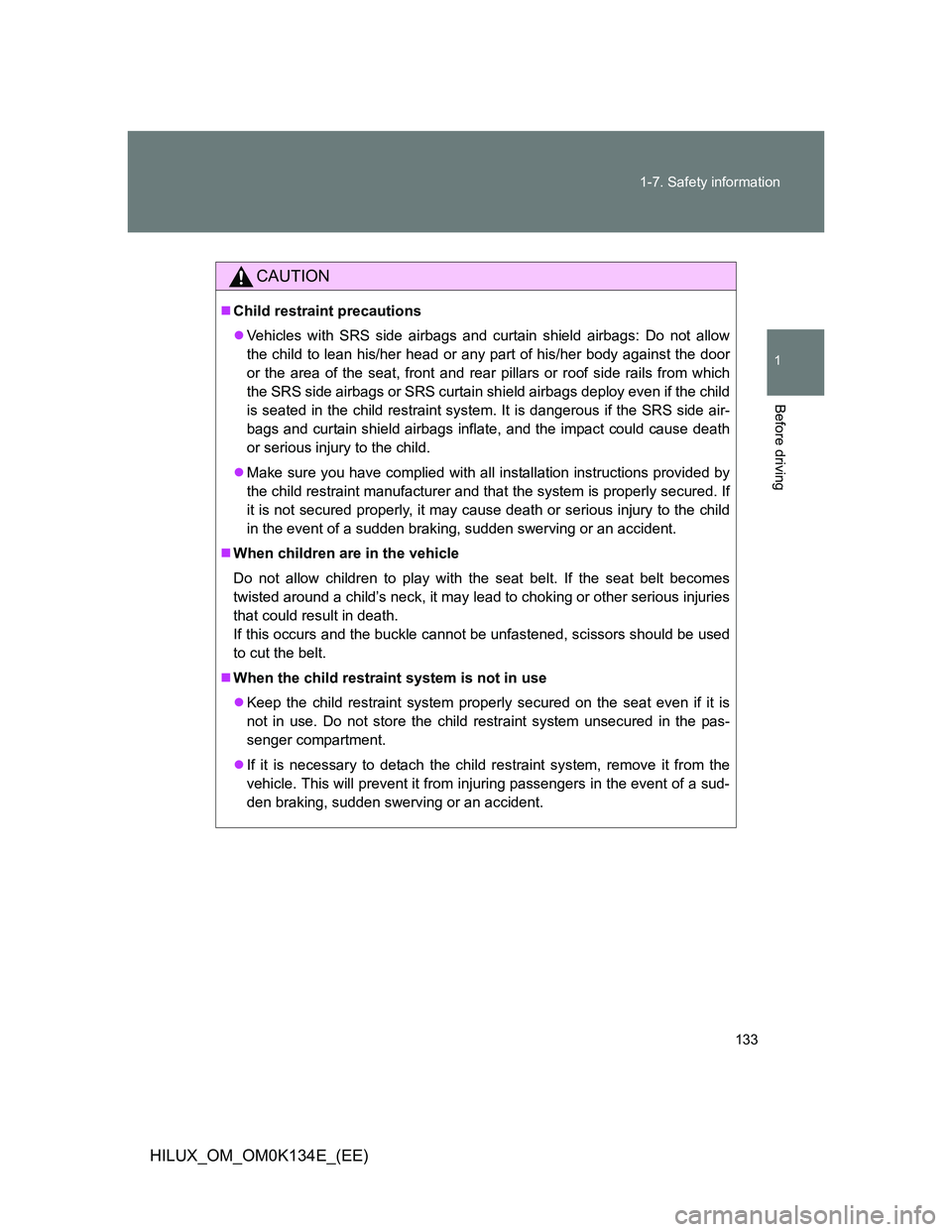Page 94 of 644
94
1-4. Opening and closing the windows
HILUX_OM_OM0K134E_(EE)
Quarter windows (extra-cab models)
Closing the quarter windows
Make sure that the quarter windows are securely closed after closing them.
CAUTION
Opening or closing the quarter windows
Observe the following precautions.
Failure to do so may result in death or serious injury.
Check to make sure that all passengers do not have any part of their body
in a position where it could be caught when a window is being operated.
Do not allow children to operate the quarter windows.
Closing a quarter window on someone can cause serious injury, and in
some instances, even death.
The quarter windows can be opened and closed using the latch han-
dle.
To open the quarter windows,
pull the latch handle toward
you and swing it fully out.
Page 95 of 644
95
1
1-4. Opening and closing the windows
Before driving
HILUX_OM_OM0K134E_(EE)
Back window (vehicles with sliding type)
Closing the back window
Make sure that the back window is securely closed after closing it.
CAUTION
Opening or closing the back window
Observe the following precautions.
Failure to do so may result in death or serious injury.
Check to make sure that all passengers do not have any part of their body
in a position where it could be caught when the window is being operated.
Do not allow children to operate the back window.
Closing the back window on someone can cause serious injury, and in
some instances, even death.
The back window can be opened and closed using the lock release
lever.
To open the back window,
push the lock release lever
and slide the back window.
Page 100 of 644

100 1-5. Refueling
HILUX_OM_OM0K134E_(EE)
CAUTION
When refueling the vehicle
Observe the following precautions while refueling the vehicle. Failure to do
so may result in death or serious injury.
After exiting the vehicle and before opening the fuel door, touch an
unpainted metal surface to discharge any static electricity. It is important to
discharge static electricity before refueling because sparks resulting from
static electricity can cause fuel vapors to ignite while refueling.
Type A only: Always hold the grips on the fuel tank cap and turn it slowly to
remove it.
A whooshing sound may be heard when the fuel tank cap is loosened.
Wait until the sound cannot be heard before fully removing the cap. In hot
weather, pressurized fuel may spray out the filler neck and cause injury.
Do not allow anyone that has not discharged static electricity from their
body to come close to an open fuel tank.
Do not inhale vaporized fuel.
Fuel contains substances that are harmful if inhaled.
Do not smoke while refueling the vehicle.
Doing so may cause the fuel to ignite and cause a fire.
Do not return to the vehicle or touch any person or object that is statically
charged.
This may cause static electricity to build up, resulting in a possible ignition
hazard.
When refueling
Securely insert the fuel nozzle into the fuel filler neck. If fuel is added with
the nozzle slightly lifted away from the fuel filler neck, the automatic shut off
function may not operate, resulting in fuel overflowing from the tank.
When replacing the fuel cap
Do not use anything but a genuine Toyota fuel tank cap designed for your
vehicle. Doing so may cause a fire or other incident which may result in
death or serious injury.
Page 102 of 644
102
HILUX_OM_OM0K134E_(EE)
1-6. Theft deterrent system
Engine immobilizer system
System maintenance
The vehicle has a maintenance-free type engine immobilizer system.
Conditions that may cause the system to malfunction
If the grip portion of the key is in contact with a metallic object
If the key is in close proximity to or touching a key to the security system
(key with a built-in transponder chip) of another vehicle
The vehicle’s keys have built-in transponder chips that prevent the
engine from starting if a key has not been previously registered in
the vehicle’s on-board computer.
Never leave the keys inside the vehicle when you leave the vehicle.
The indicator light flashes after
the key has been removed
from the engine switch to indi-
cate that the system is operat-
ing.
The indicator light stops flash-
ing after the registered key
has been inserted into the
engine switch to indicate that
the system has been can-
celed.
Page 118 of 644
118 1-7. Safety information
HILUX_OM_OM0K134E_(EE)
CAUTION
SRS airbag precautions
The SRS front passenger airbag also deploys with considerable force, and
can cause death or serious injury especially if the front passenger is very
close to the airbag. The front passenger seat should be as far from the air-
bag as possible with the seatback adjusted, so the front passenger sits
upright.
Improperly seated and/or restrained infants and children can be killed or
seriously injured by a deploying airbag. An infant or child who is too small
to use a seat belt should be properly secured using a child restraint sys-
tem. Toyota strongly recommends that all infants and children be placed in
the rear seats of the vehicle and properly restrained. The rear seats are
safer for infants and children than the front passenger seat. (P. 122)
Page 123 of 644
123 1-7. Safety information
1
Before driving
HILUX_OM_OM0K134E_(EE)
Types of child restraints
Child restraint systems are classified into the following 5 groups
according to the regulation ECE No.44:
Group 0: Up to 10 kg (22 lb.) (0 - 9 months)
Group 0
+: Up to 13 kg (28 lb.) (0 - 2 years)
Group I: 9 to 18 kg (20 to 39 lb.) (9 months - 4 years)
Group II: 15 to 25 kg (34 to 55 lb.) (4 years - 7 years)
Group III: 22 to 36 kg (49 to 79 lb.) (6 years - 12 years)
In this owner’s manual, the following 3 types of popular child restraint
systems that can be secured with the seat belts are explained:
Page 132 of 644

132 1-7. Safety information
HILUX_OM_OM0K134E_(EE)
CAUTION
Using a child restraint system
The use of a child restraint system not suitable for the vehicle may not prop-
erly secure the infant or child. It may result in death or serious injury (in the
event of sudden braking or an accident).
Child restraint precautions
For effective protection in automobile accidents and sudden stops, a child
must be properly restrained, using a seat belt or child restraint system
depending on the age and size of the child. Holding a child in your arms is
not a substitute for a child restraint system. In an accident, the child can be
crushed against the windshield, or between you and the vehicle’s interior.
Toyota strongly urges the use of a proper child restraint system that con-
forms to the size of the child, installed on the rear seat. According to acci-
dent statistics, the child is safer when properly restrained in the rear seat
than in the front seat.
Never install a rear-facing child restraint system on the front passenger
seat.
In the event of an accident, the force of the rapid inflation of the front pas-
senger airbag can cause death or serious injury to the child if the rear-fac-
ing child restraint system is installed on the front passenger seat.
A forward-facing child restraint system may be installed on the front pas-
senger seat only when it is unavoidable. Adjust the seatback as upright as
possible and always move the seat as far back as possible because the
front passenger airbag could inflate with considerable speed and force.
Otherwise, the child may be killed or seriously injured.
Page 133 of 644

133 1-7. Safety information
1
Before driving
HILUX_OM_OM0K134E_(EE)
CAUTION
Child restraint precautions
Vehicles with SRS side airbags and curtain shield airbags: Do not allow
the child to lean his/her head or any part of his/her body against the door
or the area of the seat, front and rear pillars or roof side rails from which
the SRS side airbags or SRS curtain shield airbags deploy even if the child
is seated in the child restraint system. It is dangerous if the SRS side air-
bags and curtain shield airbags inflate, and the impact could cause death
or serious injury to the child.
Make sure you have complied with all installation instructions provided by
the child restraint manufacturer and that the system is properly secured. If
it is not secured properly, it may cause death or serious injury to the child
in the event of a sudden braking, sudden swerving or an accident.
When children are in the vehicle
Do not allow children to play with the seat belt. If the seat belt becomes
twisted around a child’s neck, it may lead to choking or other serious injuries
that could result in death.
If this occurs and the buckle cannot be unfastened, scissors should be used
to cut the belt.
When the child restraint system is not in use
Keep the child restraint system properly secured on the seat even if it is
not in use. Do not store the child restraint system unsecured in the pas-
senger compartment.
If it is necessary to detach the child restraint system, remove it from the
vehicle. This will prevent it from injuring passengers in the event of a sud-
den braking, sudden swerving or an accident.